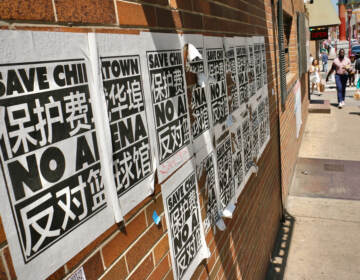Chinatown is building the gathering space the community needs
Since its beginnings, Chinatown has never had a space of its own. There have never been public facilities for people to gather, celebrate and be together.

Chinatown children and elders walk for safe routes to parks and schools during Chinatown Connections Parade in 2016. (Rachael Warriner/PCDC)
There is a new high-rise in the Philly skyline. The Crane, a new mixed-use community center, rises dramatically at the end of Chinatown’s commercial corridor, set apart from the characteristic brick and mid-rise buildings of the neighborhood. Recent stories have criticized its lack of affordable housing and questioned the inclusion of a tower of market-rate apartments behind the community center. I was the project manager for the Crane from 2014 to 2018 and when I think about the building, my eyes are not drawn upwards.
Instead, I look across the street.
Every day when school lets out, children in Chinatown line up at 10th and Vine Street to cross the Vine Street Expressway. Hand-in-hand, they walk the long, meandering route to local after school programs across the neighborhood, and from there, down the interminable stretch of sidewalk between Chinatown and its closest park, Franklin Square. Their tiny figures are lost in a landscape of cars.
Since its beginnings, Chinatown has never had a space of its own. There have never been public facilities for people to gather, celebrate and be together. Chinatown doesn’t even qualify for Rebuild because the city says that program is for communities which already have those facilities. During urban renewal, its own streets and sidewalks turned against the neighborhood – projects such as the Vine Street Expressway and the Franklin Urban Renewal Plan created huge barriers to pedestrian activity and community growth. Chinatown was hemmed in on all sides.
We adapted.

In the early 20th century, the local churches founded the Yu Pin basketball team, established music and ESL classes and became intergenerational gathering places for elders, children and working parents. Festivals like the Mid-Autumn Festival and Chinese New Year, important touchstones to celebrate ties of culture and family, took place all over – in restaurants, institutional spaces and spilling out into the streets. Today, those traditions continue.
The Crane was inspired by the children from FACTS Charter School and Holy Redeemer who have recess in a parking lot. It was inspired by the elders who practice tai chi elbow-to-elbow in the cramped Chinatown office space of On Lok Senior Center, and the generations of Philadelphia Suns youth who grew up playing basketball and anchoring themselves in their culture and their community in the backyard of the Chinese Christian Church and Center. Members of the Suns stood in the path of bulldozers during the Save Chinatown Movement, bodily protecting the community against the proposed Vine Street Expressway in the 1970s. Today, these are men, women and youth for whom sports, culture and community are inextricable values.

The Crane is the place where we dreamed all this history could come to a head, where at last, we would have a home base, worthy of all the resilience and meaning that our community has created out of scarcity and hardship, here and in our families’ countries of origin.
The Crane is not a perfect project. As we found ourselves at the end of the development process, we were not able to do as much as we wanted to with the project we had and dropped the affordable housing in order to preserve the community center. We faced the reality of what we could do without the annual operating support that every other recreation center in the city receives. Many nonprofit spaces in Philadelphia must engage in rent-seeking efforts in order to survive.
However, communities of color like Chinatown are often left to solve their own problems. They have to go through huge efforts to do so, confront the challenges they inherit from historical injustices, and fight to keep their agency in the process. The results often look different from the molds that we have come to expect. That should be allowed – and what’s more, it should be celebrated for the innovation and adaptivity inherent in these projects.

Three years ago, another little boy who grew up next to a highway stood on the 10th and Vine Street pedestrian bridge above the Expressway. That former little boy, then-United States Secretary of Transportation Anthony Foxx, spoke about how we outgrow the plans we make for ourselves and the potential of infrastructure to connect our communities, rather than divide them. As part of the Every Place Counts initiative, the Department of Transportation selected Philadelphia Chinatown as one of four places across the country to receive assistance to make Vine Street work for all users, not just cars.
Today, those plans are moving forward. Our community is moving forward.
Projects like the Crane will honor our history and cultural identity, while giving our families the opportunities they deserve. Instead of playing in parking lots, our children will run freely in a state-of-the-art gym. The Suns will have a home court. Our festivals and banquets will look out onto the city skyline. Celebrate with us, because for the first time, our community will have a place to call its own.
WHYY is your source for fact-based, in-depth journalism and information. As a nonprofit organization, we rely on financial support from readers like you. Please give today.







